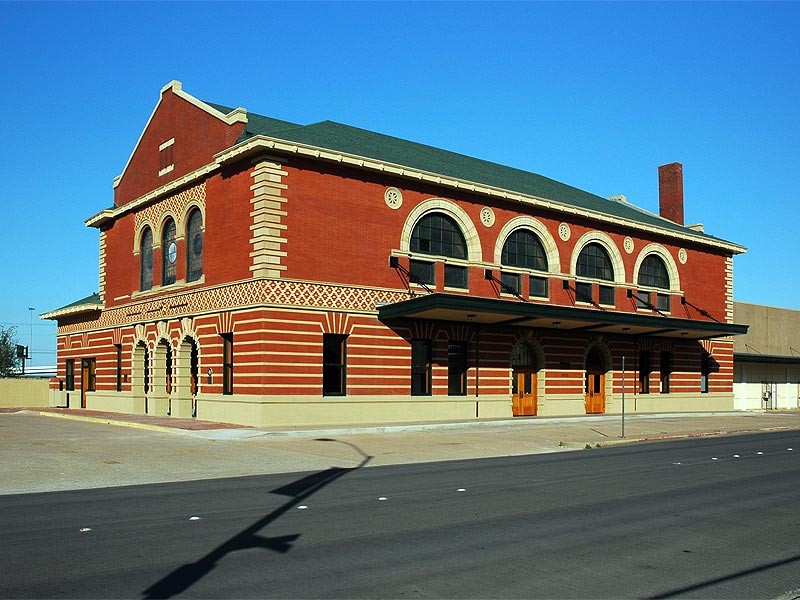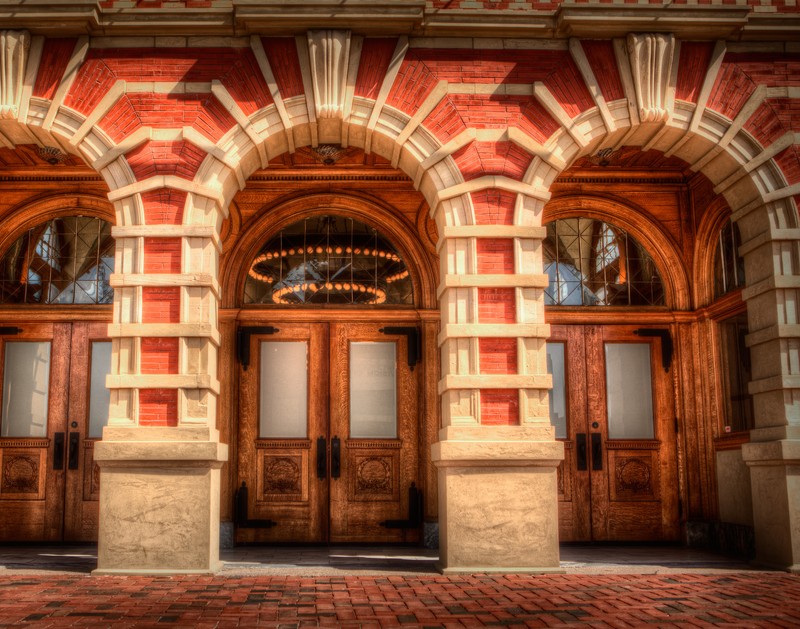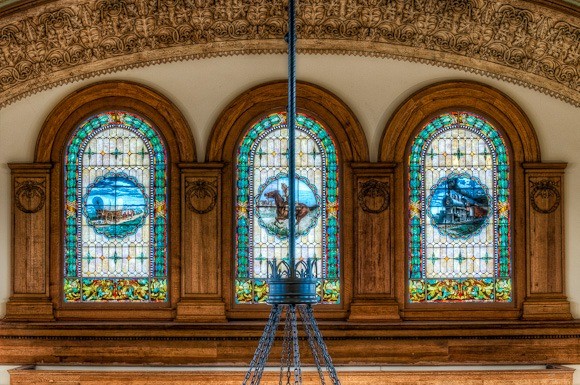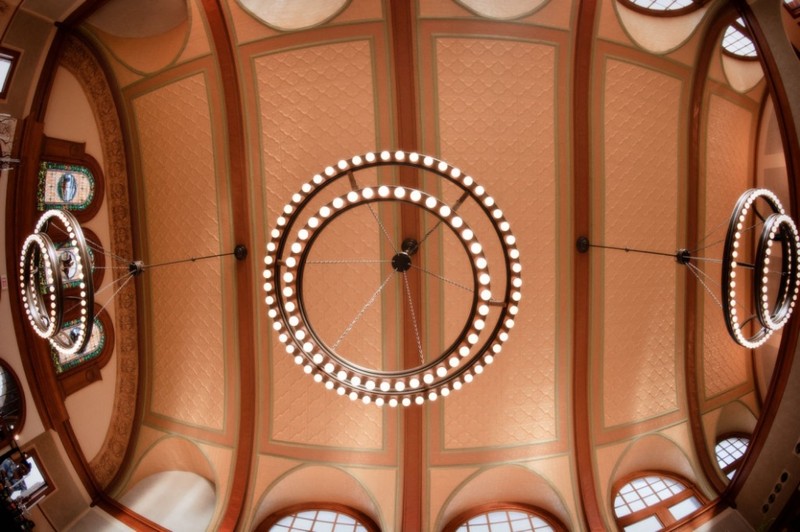Ashton Depot
Introduction
Text-to-speech Audio
Currently operating as a meeting and banquet facility for the Ashton Hotel, Ashton Depot (originally the Santa Fe Depot) was opened in 1899 response to Fort Worth's growing population's demand for railroad service. The Depot has truly witnessed some of the most historic events of the Twentieth Century.
Images
Ashton Depot Profile.

Red-and-white stonework.

Ashton Depot stained glass.

Ashton Depot ceiling.

Backstory and Context
Text-to-speech Audio
The Ashton Depot, originally known as the Sante Fe Depot, was opened on March 1 of 1899.1 Fort Worth's population had boomed during the late 19th Century as railroads made transportation easier, cheaper, and faster than ever before. The city had previously allowed the construction of the Teas and Pacific Railway's depot on Lancaster Avenue, a massive structure that served as the primary station for the entire city. As the population grew, city officials found that the existing railroad infrastructure was unable to cope with the heavy passenger traffic, and commissioned the beautiful structure that stands today. The Depot was designed to relieve mounting pressure on other local stations, and is known today for its historic architecture.
The building is styled in the beaux arts styles, which contributes to its red-and-white stone banding and decorative brickwork.2 There is no historic record that tells the name of the architect who designed this building, though it was recently discovered that the contractors were David Smith and John Bardon.3 The Ashton Depot serviced several railroad lines that ran through Fort Worth, including both the Santa Fe, and Amtrak.4 Over the years that followed the Depot's construction, the freight station next door was converted into the University of Texas at Arlington Fort Worth Center.
During 1937, the Depot was renovated by the Fort Worth Union Passenger Station and the Santa Fe Railroad.5 This renovation followed the demolition of the original Texas and
Pacific Railway depot on Lancaster Avenue, a structure that was replaced in 1931. The renovation of Ashton Depot followed the construction of the Texas and Pacific building, and saw the removal of many of the Depot's iconic features, including the stained glass, marble floor, and decorative electric lights in an attempt to "modernize" the structure. All of these artifacts and design elements have since been found and returned to the Depot. Following the renovation, the station served many lines. This continued until 1960, when the Santa Fe line became the sole provider to use the facility.6
Today, thanks to private backers, the facility has been fully restored at considerable expense. The original stained-glass windows, barrel-vaulted ceilings, and marble floors were re-located, uncovered, and brilliantly restored to dazzle visitors and historians alike. This restoration was completed in 2006.7 Since then, the building continues to serve Fort Worth, but now as an event center, wedding venue, and for other private functions.8 It serves Fort Worth's Ashton Hotel, a "upscale boutique hotel" that is in the heart of Fort Worth's historic Sundance Square, Bass Performance Hall, and near the Fort Worth Stockyards.9
The building is styled in the beaux arts styles, which contributes to its red-and-white stone banding and decorative brickwork.2 There is no historic record that tells the name of the architect who designed this building, though it was recently discovered that the contractors were David Smith and John Bardon.3 The Ashton Depot serviced several railroad lines that ran through Fort Worth, including both the Santa Fe, and Amtrak.4 Over the years that followed the Depot's construction, the freight station next door was converted into the University of Texas at Arlington Fort Worth Center.
During 1937, the Depot was renovated by the Fort Worth Union Passenger Station and the Santa Fe Railroad.5 This renovation followed the demolition of the original Texas and
Pacific Railway depot on Lancaster Avenue, a structure that was replaced in 1931. The renovation of Ashton Depot followed the construction of the Texas and Pacific building, and saw the removal of many of the Depot's iconic features, including the stained glass, marble floor, and decorative electric lights in an attempt to "modernize" the structure. All of these artifacts and design elements have since been found and returned to the Depot. Following the renovation, the station served many lines. This continued until 1960, when the Santa Fe line became the sole provider to use the facility.6
Today, thanks to private backers, the facility has been fully restored at considerable expense. The original stained-glass windows, barrel-vaulted ceilings, and marble floors were re-located, uncovered, and brilliantly restored to dazzle visitors and historians alike. This restoration was completed in 2006.7 Since then, the building continues to serve Fort Worth, but now as an event center, wedding venue, and for other private functions.8 It serves Fort Worth's Ashton Hotel, a "upscale boutique hotel" that is in the heart of Fort Worth's historic Sundance Square, Bass Performance Hall, and near the Fort Worth Stockyards.9
Sources
1. "History." The Ashton Depot. 2015. http://theashtondepot.com/history/.
2. Roberts, John, AIA. "Ashton Depot." Architecture in Fort Worth. 2015. Accessed August 11, 2016. http://www.fortwortharchitecture.com/allen.htm
3. Ibid.
4. Ibid.
5. "History." The Ashton Depot. 2015. http://theashtondepot.com/history/.
6. Ibid.
7. Ibid.
8. Ibid.
9. "The Ashton Hotel." The Ashton Hotel. 2016. Accessed August 11, 2016. http://www.theashtonhotel.com.
